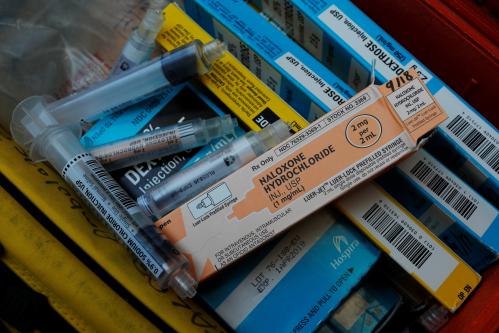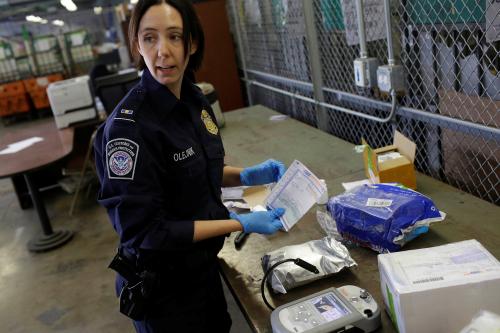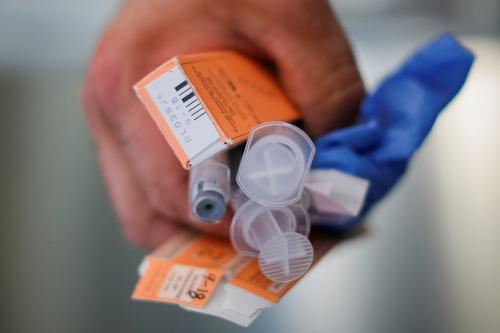In a 2018 article for Foreign Affairs, we detailed what set off the North American opioid crisis and what other nations can learn from mistakes the U.S. and Canada made. Here, we describe the opioid situation in other countries and then reflect on what U.S. and Canadian officials could learn from them. Key lessons include that flooding the health care system with prescription opioids isn’t necessary to manage the population’s pain, guaranteed health care access may help slow opioid epidemics, and the rules for how opioids are prescribed matter, among others.
Unscrupulous U.S. pharma companies are exporting the opioid epidemic abroad
Opioid prescribing in multiple Western countries (e.g. the Netherlands, the United Kingdom, Israel) has risen significantly over the past decade, though not yet to U.S. levels. The more explosive growth is in middle- and low-income countries.
Much of the new growth is fueled by U.S. companies, including Mundipharma, which like Purdue Pharma is owned by the Sackler family. Purdue drove early stages of the U.S. opioid crisis by promoting OxyContin in misleading and unethical ways, notably misrepresenting its risk of addiction when used to treat chronic, non-cancer pain. Likewise, Mundipharma has actively lobbied to open up European countries to greater opioid prescribing, as well as sponsored doctors to promote prescription opioids and deny their high potential for addiction. It has also set up and financed ostensibly patient-led groups to advocate greater access to opioids. In Poland, this has produced new legislation allowing any doctor, not merely specialty pain doctors, to write opioid prescriptions. In Italy, Mundipharma’s business practices have already triggered police and legal investigations. Some Western European companies, such as Germany’s Grunenthal, have copied Mundipharma’s tactics.
Mundipharma has also set up joint ventures with powerful pharmaceutical companies in developing countries with huge populations, such as India and Brazil. These joint ventures have great potential to cause addiction around the globe, as they already operate supply networks in their countries and broader regions and have extensive experience in lobbying governments and populations. India’s pharmaceutical industry has been weakly regulated, with an even higher capacity for policy and regulatory capture than has afflicted the United States. As an important driver of India’s economic growth and job generation, the pharmaceutical industry exercises powerful influence on India’s government. It has lately been pressuring the government of Narendra Modi to raise ceilings on drug prices and expand support for its activities abroad. India has substantial undertreated pain; if India’s pharmaceutical companies embrace Western-supplied opioids or produce their own generic morphine primarily for acute or cancer pain, that would not be problematic. However, from Delhi to Mumbai to Kolkata, for-profit pain clinics are proliferating, and addiction is rising. Small and large Indian companies sell powerful opioids for all kinds of pain. Some employ legal tricks to avoid regulations, and some engage in frankly illegal diversion. In Brazil, already reeling from a decade-old crack cocaine epidemic, prescriptions for opioid painkillers grew by 465% in six years.
The joint ventures with Indian firms also give U.S. pharma companies access to markets across the Middle East and Africa. Pain is critically under-medicated in those regions, but corruption in the pharmacy system often results in opioids feeding addiction rather than only being used compassionately. In Nigeria, for example, tramadol in theory requires a prescription; but a less than $10 bribe in a pharmacy will enable a customer to buy it because of pervasive corruption and poor law enforcement. Similar problems are evident in other nations, including Iraq and Lebanon.
China and India remain obstacles to controlling illicit synthetic opioids
Meanwhile, China has historically exerted minimal control over producers of illicit fentanyl and other synthetic opioids. Under U.S. pressure, it “scheduled” all analogs of fentanyl in 2019 — meaning that their production and export now are regulated and require special permits. But Beijing’s capacity to enforce the new rules remains limited, and — in the midst of ongoing rancor with the United States — its motivation to do so may be lacking as well. Although at least 5,000 pharmaceutical and 160,000 chemical companies operate hundreds of thousands of production facilities, it only has some 2,000 inspectors who conduct as few as 600 inspections per year. China could tighten controls by increasing the number of inspectors, conducting sting operations and unannounced inspections, and mandating that all facilities have 100% close-circuit TV coverage monitored by independent inspectors. But boosting capacity along those lines requires will, and China may not find that will until more of its own population becomes addicted to pharmaceutically produced opioids. As of now, China’s users still mostly consume heroin and methamphetamine from Myanmar, with cocaine from Latin America being the new exciting fad.
What the United States and Canada can learn from other countries
If the rest of the world is thus far not learning much from U.S. and Canadian policy failures, can the latter learn from the former? We offer five such lessons.
Lesson 1: Flooding the health care system with prescription opioids is not needed for population pain management.
Pharmaceutical companies and patient advocacy groups (some of which are industry-funded) argue that the near-quadrupling of opioid prescribing that began in the mid-1990s was a necessary response to an extraordinary level of pain in the population. But there is no evidence that the United States, which after all has one of the youngest populations in the developed world, experiences more pain than other countries. Neither is there any evidence that the explosion of opioid prescribing that began in the mid-1990s reduced population pain in the U.S.
Meanwhile France, the developed country which population pain surveys indicate is most similar to the United States, consumes barely one-fifth the prescription opioids on a per capita basis. The U.S. high prescribing level is not a necessary consequence of its level of population pain.
The U.S. high prescribing level is not a necessary consequence of its level of population pain.
Lesson 2: Guaranteed health care access may, paradoxically, help slow opioid epidemics.
Limits to accessing care can make the epidemic worse. The structure of insurance benefits in the U.S. often incentivizes prescribing (relatively cheap) opioids over the more extended care an individual may need (e.g., a course of physical therapy, orthodontic surgery, extended mental health treatment). The U.S. practice of tying high-quality health insurance to employment — unique among developed countries — often means that severely addicted people will not get substance use disorder (SUD) treatment because they cannot obtain or hold down such jobs. Furthermore, the patchwork system of uncoordinated providers and payers makes it easier for people with SUD to obtain multiple prescriptions from different sources (“doctor shop”), sometimes to the point of being able to sell pills to others. Adopting one of the universal coverage approaches present in other developed nations, including universal health care records, could help the U.S. address these challenges.
Lesson 3: The rules under which opioids are prescribed matter.
The number-one per capita consumer of opioids in the world is the U.S., and Canada is third. Germany is second, but by all accounts it does not have an opioid epidemic. Why not?
Germany’s high per capita opioid consumption rate is driven by extensive use of opioids in institutional settings (e.g., fentanyl during inpatient surgery). But unlike in Canada and the United States, in Germany prescriptions for chronic non-cancer pain are uncommon for people living outside of medical facilities. Only 4.5% of Germans living in the community receive an opioid prescription each year, versus 20% of Canadians. This means that in Germany, there is far less medically unsupervised opioid use and far fewer opioid pills accumulating in medicine cabinets, where they can be accessed by people other than the intended patient.
It’s not just the volume of opioid prescribing that matters, but where and how opioids are prescribed and used.
The international data thus suggest that it’s not just the volume of opioid prescribing that matters, but where and how opioids are prescribed and used. It was the combination of expanded prescribing under conditions of minimal patient oversight that proved problematic in the U.S. and Canada.
Lesson 4: Fentanyl supply can sometimes remain regional, not universal.
People who become addicted to prescription opioids often “trade down” to purchase opioids from illegal markets. In parts of North America, this now presents a high risk of being exposed to extremely deadly synthetic opioids, such as fentanyl, which dealers increasingly use to adulterate heroin and counterfeit opioid pills in those regions.
So far, synthetic opioids are common in only some North American markets. As a recent RAND report observed, 9,000 more Americans would die each year if the per capita rate of synthetic opioid-related deaths in the rest of the country rose to even half what it was in New England in 2017. The geography is similar but reversed in Canada, where western not eastern provinces — notably British Columbia and Alberta — are the most severely affected.
Markets in more regions might embrace synthetic opioids, amplifying death rates, because fentanyl costs wholesale drug dealers only about 1% as much per morphine-equivalent dose as does heroin. However, the sharp east-west gaps now seen in Canada and the U.S. may persist. After all, many countries’ illegal markets do not yet have fentanyl, but could. For example, when heroin markets were disrupted in 2001 and Estonia got fentanyl, its neighbor Finland got (black-market) buprenorphine instead. Finland’s black-market suppliers eschewed fentanyl for no obvious reason, but fentanyl has now been entrenched in Estonia for nearly 20 years, while remaining rare just 50 miles away in Finland. Unsurprisingly, Finland’s drug-related death rates remain well below those in Estonia.
A moral for the U.S. and Canada is not to give up hope that strong efforts might block fentanyl’s spread and spare some regions from suffering the horrific death rates now observed in British Columbia, New England, and Appalachia.
Lesson 5: Once synthetic opioids become entrenched, they tend to persist.
Local outbreaks of synthetic opioids sometimes fizzle, but there is essentially no example of a major market where synthetic opioids disappeared after becoming entrenched. In the words of the RAND report, synthetic opioids’ spread may be episodic, but it has ratchet-like persistence.
That is understandable. Synthetic opioids present a more elusive target for law enforcement than does heroin. Unlike opioids derived from poppy crops, synthetic opioids can be produced anywhere, and in small, indoor operations. Some of them are so extraordinarily potent — at least 25 times as potent, per gram, as heroin — that the quantities transported are much smaller.
This suggests that although regions that have not yet been heavily affected have good reason to try to resist incursions, once synthetic opioids have become established, efforts to root out that supply may be quixotic.
We see evidence that prescription opioid led crises are being fomented in multiple regions around the world, perhaps sending more countries down the agonizing path trod by the United States and Canada. Neither the U.S. approach to drug policy nor the very different approach in Canada has been able to prevent very large increases in opioid overdose deaths. However, we have described five lessons from abroad that the U.S., Canada, and these additional regions might apply to lessen the destruction of their ongoing epidemics.
The Brookings Institution is committed to quality, independence, and impact.
We are supported by a diverse array of funders. In line with our values and policies, each Brookings publication represents the sole views of its author(s).











Commentary
What the US and Canada can learn from other countries to combat the opioid crisis
January 13, 2020